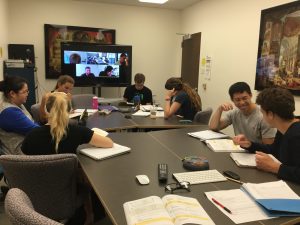
Being part of the ONL course has been really eye-opening for me. When I signed up for ONL 241, I was hoping to shake things up a bit and find some new ideas. I felt like I was in a bit of a rut at work. In Topic 1, we talked a lot about how anxiety affects teaching and learning. It was interesting to see that it’s not just me—lots of teachers and students feel the same way. One thing we all agreed on was that we could use more training in digital tools and online teaching. The pandemic didn’t help either, with everyone scrambling to find quick fixes. But being in ONL has been great because it’s given us a chance to really dig into these issues and come up with some creative solutions.
Looking back on my experience in ONL, I’ve realized how important it is to strike a balance between goal-oriented teaching and collaborative learning, especially after diving into Topic 3. Growing up in Sweden, where teamwork is a big deal, I naturally leaned towards a more collective teaching style. But being part of ONL has made me rethink that a bit. While teamwork has its perks, I’ve been reminded of that it’s crucial to take into account individual learning styles and have clear goals for assessment. This has pushed me to rethink how I teach and find ways to blend both collaborative and goal-oriented approaches more clearly. I’m more focused on creating learning spaces where everyone feels included and supported, no matter their learning style.
The part of the course that really opened my eyes though was Topic 2. We dove into openness in education and Open Educational Resources (OER), which made me see just how crucial accessibility and inclusion are in making education fairer. It got me thinking deeply and led me to rethink my perspective. Before this, I naturally knew about open-access resources and the unequal access to education worldwide, but the course gave me a fresh perspective and made me question my old ideas.
The conversations and tasks in Topic 2 shed light on the different aspects of openness in education, showing how it can help level the playing field and empower learners from all walks of life. Exploring Open Educational Resources (OER) was a real eye-opener for me. It made me realize the importance of making educational materials available to everyone, regardless of where they are, how much money they have, or their educational background. This new understanding has inspired me to bring more open educational practices into my teaching. I’ll try to create a more inclusive learning space by using OER in my teaching materials and embracing open teaching methods. My goal is to give more people access to education and help them succeed academically, not just to my students, but to the world.
All in all, Topic 2 really changed my perspective on openness in education and motivated me to take real steps toward making education more accessible and inclusive in my own teaching. It made me rethink how I teach and reminded me to focus on creating environments where everyone feels welcome and valued, regardless of their background.
Besides the course material, what really stood out for me was the experience in PBL Group 2. I’ve never been in such a well-coordinated and enriching collaborative environment before. Our teamwork was seamless, and our PBL sessions were both productive and fun. Almost everyone showed up for every meeting – it felt like it mattered to all of us to connect and contribute. I’m really happy about how well we all clicked and plan to stay in touch even after the course wraps up.
Based on what I’ve learned in ONL, I’m planning to make changes to my teaching approach. The fast adoption of technology, some driven by Covid, has changed how we teach and learn, making online education more common. But in the midst of all this change, I’m reminded how crucial it is to hold onto the personal touch in teaching and to keep those human connections alive. I want to be more open to new ideas and technologies, while still keeping that human touch. I’ll be focusing on creating a more collaborative and inclusive classroom, where everyone’s voice is heard and at the same time see what I can do when it comes to the work towards opening up to the world. Thank you, ONL!


